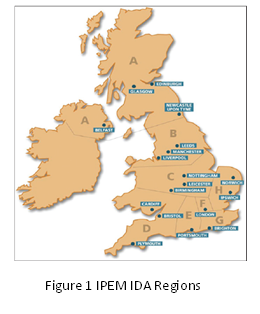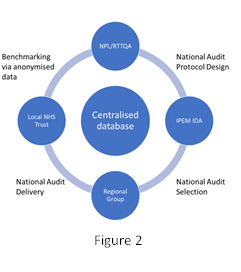In the UK, participating in dosimetry audits are recommended as best practice in radiotherapy prior to a machine first entering clinical use, credentialing for clinical trials, implementation of new techniques and to ensure maintaining and improving standards [1,2]. Repeated regional and national UK audits since 1987 have shown improvement in treatment accuracy, with the reduction in standard deviation of the absolute dose accuracy [3].
There are currently three groups in the UK who provide dosimetry audit: The National Physical Laboratory (NPL), the National Radiotherapy Trials Quality Assurance Group (RTTQA) and the IPEM (Institute of Physics and Engineering in Medicine) Interdepartmental Dosimetry Audit Group (IDA).
NPL provides dosimetry audit for novel techniques being implemented into the clinic and works to develop dosimetric capability for the upcoming techniques which will be treatments of the future, such as FLASH.
RTTQA requires all centres participating in clinical trials with a radiotherapy component to have received an independent dosimetry audit at least once every 5 years, as long as there have been no major changes in equipment, calculation algorithm or technique, and holds a database of all audits conducted.
The audits undertaken by NPL/RTTQA have included the national HDR brachytherapy audits 2013-2016[4], the national rotational IMRT audit in 2014[5], stereotactic radiosurgery audit in 2017-2019[6], Lung SABR audit [7] and spine SABR audit which are both ongoing.
The IDA was set up in the 1990s by IPEM following the findings of the first UK photon dosimetry audit [8]. The IPEM IDA support follow-up audits at local centres, once new techniques are established, through a network of regional groups as depicted in figure 1. This regional audit system consists of 8 cooperative regions (figure 1), with 5-12 members per region and including 61 centres. The regional chairs coordinate on-site external audits (for new equipment or techniques) within the region, annual peer-to-peer audits and report back at the annual IDA meeting. All radiotherapy dosimeters used in audit are traceable to the NPL’s primary standard for each treatment modality.


The scientific leads from the IPEM IDA, NPL and RTTQA have worked together to create a joint vision to complete the audit cycle and bring together all UK dosimetry audit data to enable quality improvement and provide evidence of high quality provision for both trial QA and ongoing routine treatments (figure 2). Collaboration and data sharing between these groups is building an infrastructure to create a complete picture of audit activity across the UK to ensure that all centres can access the audit they need, thus ensuring a world-class provision of quality.
[1] NHS England (2019) External Beam Service Specifications. https://www.england.nhs.uk/wp-content/uploads/2019/01/External-Beam-Radiotherapy-Services-Delivered-as-Part-of-a-Radiotherapy-Network-Adults.pdf
[2] RCR, SCoR, IPEM, NPSA, BIR (2008), Towards Safety Radiotherapy, The Royal college of radiolgoists. https://www.rcr.ac.uk/system/files/publication/field_publication_files/Towards_saferRT_final.pdf
[3]Clark, C. H et al (2015). Radiotherapy dosimetry audit: three decades of improving standards and accuracy in UK clinical practice and trials. The British journal of radiology, 88(1055), 20150251. https://doi.org/10.1259/bjr.20150251
[4] Díez, P et al (2017). A multicentre audit of HDR/PDR brachytherapy absolute dosimetry in association with the INTERLACE trial (NCT015662405). Physics in medicine and biology, 62(23), 8832–8849. https://doi.org/10.1088/1361-6560/aa91a9
[5] Clark, C. H et al (2014). A multi-institutional dosimetry audit of rotational intensity-modulated radiotherapy. Radiotherapy and oncology : journal of the European Society for Therapeutic Radiology and Oncology, 113(2), 272–278. https://doi.org/10.1016/j.radonc.2014.11.015
[6] Dimitriadis, A et al (2020). Multi-institutional dosimetric delivery assessment of intracranial stereotactic radiosurgery on different treatment platforms. Radiotherapy and oncology : journal of the European Society for Therapeutic Radiology and Oncology, 147, 153–161. https://doi.org/10.1016/j.radonc.2020.05.024
[7] Distefano, G et al (2017). A national dosimetry audit for stereotactic ablative radiotherapy in lung. Radiotherapy and oncology : journal of the European Society for Therapeutic Radiology and Oncology, 122(3), 406–410. https://doi.org/10.1016/j.radonc.2016.12.016
[8] Thwaites, D. I et al (1992). A dosimetric intercomparison of megavoltage photon beams in UK radiotherapy centres. Physics in medicine and biology, 37(2), 445–461. https://doi.org/10.1088/0031-9155/37/2/011